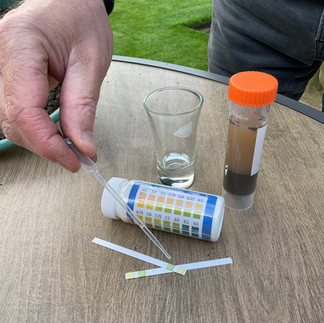Getting to know your soil
- awoolcott1
- May 5, 2024
- 3 min read

Soil is the most important thing you have in your garden. It is what gives life to your plants and what sustains them, it provides food, water, structural support, drainage, and oxygen. Getting to know a little bit about what type of soil you have will make a massive difference to your gardening success.
In general, soil is a mixture of organic matter and various minerals (affected by the unlaying rock), water, air, and micro-organisms. The proportion of these components can vary greatly across the country meaning that not everybody’s garden soil will be the same.
Traditionally, soil is classified into four types based on their structure: sandy soil, clay soils, silty soils, and loamy soils. Sandy soils such as the one I have in my own garden in Norfolk, are light, dry, free draining but low in nutrients because they lack organic matter to hold on to them. Sandy soils can also be slightly acidic. Clay soils are heavy and cloddy, sometimes hard to work but tend to be high in nutrients and stay wet for longer. Silty soils can still be quite light and free draining and tend to be quite fertile. Loamy soils are a mixture of sandy, silty and clay soils in varying degrees. Knowing what soil type you have will let you choose the right plants for the soil that you have. Some plants will do better on heavier clay soils such as roses and hydrangeas and some plants will do better on lighter sandy soils such as lavenders and rosemary.
The best way to find out what type of soil you have is to dig a few holes in various parts of the garden and pick it up and roll it around in your hands. Sandy soil is just like a beach, it feels gritty and won’t easily be rolled into a ball. Clay soil often feels like wet, modelling clay and you can roll it into shapes, and it holds its form. Silty soil can feel a bit light like sand, but it isn’t as gritty, often it feels soapy but doesn’t hold its shape as much as clay soils. Once you know what soil you have then you can improve. For example, if you have a sandy soil then adding extra compost or manure will improve the level of organic matter, add extra nutrients, and help it to retain moisture more effectively.


The other important thing you will need to know is your soil pH. This is a measure of how acidic (low pH) or alkaline (high pH) your soil is. This will affect what plants you can grow in your garden. Some plants such as Rhododendrons and azaleas prefer a lower pH, an acid or ericaceous soil. Other plants such as lavenders and hardy geraniums prefer more alkaline soils. Most plants in your garden will be happy in the middle, what’s called a neutral pH.
One way to find out what your soil pH is to look at the plants in people’s gardens in your neighbourhood. The chances are that if there are a lot of rhododendrons around then you too have more of an acidic soil. You can also buy soil testing kits online or at garden centres to get a better idea of what your soil pH is.
It’s all about right plant for the right place and taking a bit of time to get to know your soil will help you get the most out of your garden and give your plants the best and most appropriate conditions to thrive.









Comments